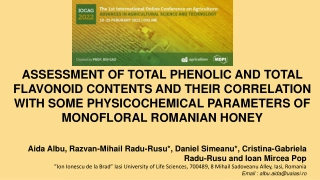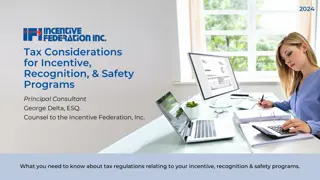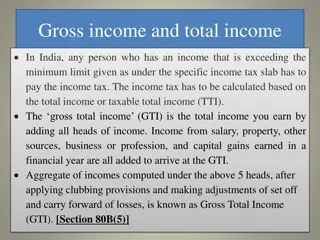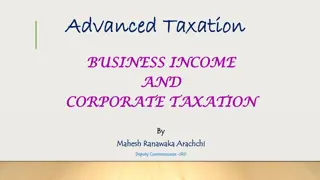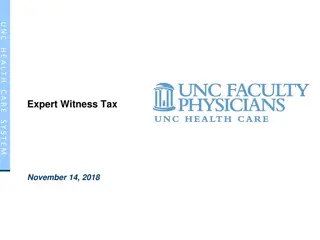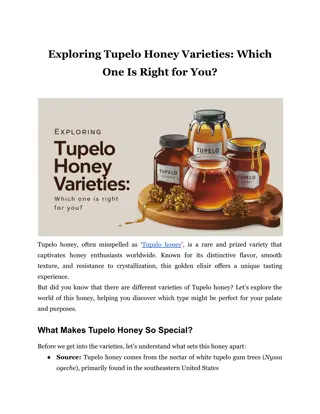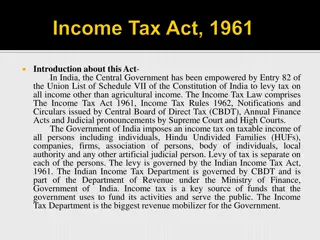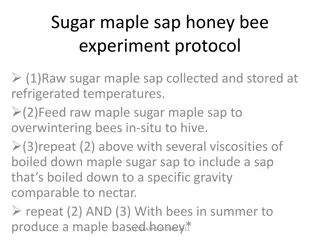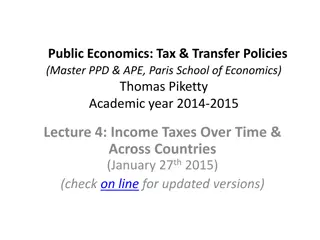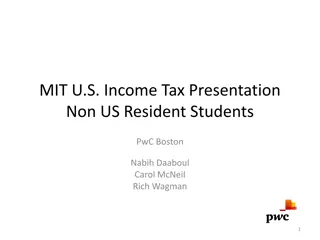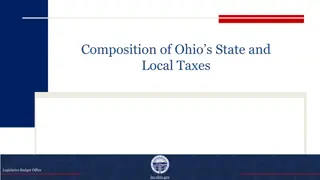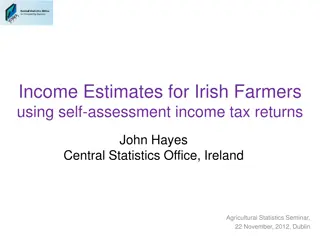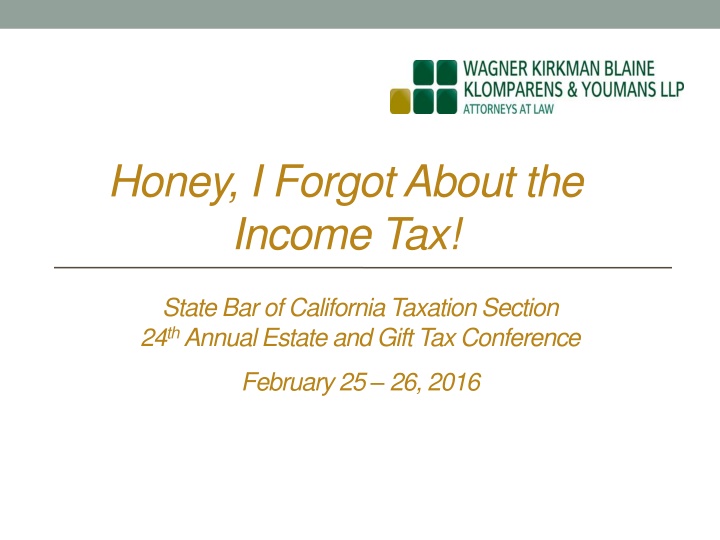
Income Tax Planning in Estate and Gift Tax Conference
Explore the intersection of income tax issues and estate planning, focusing on strategies to minimize estate tax while addressing income tax implications. Learn about net investment income tax implications and essential components of estate planning. Stay informed and prepared for effective financial management.
Download Presentation

Please find below an Image/Link to download the presentation.
The content on the website is provided AS IS for your information and personal use only. It may not be sold, licensed, or shared on other websites without obtaining consent from the author. If you encounter any issues during the download, it is possible that the publisher has removed the file from their server.
You are allowed to download the files provided on this website for personal or commercial use, subject to the condition that they are used lawfully. All files are the property of their respective owners.
The content on the website is provided AS IS for your information and personal use only. It may not be sold, licensed, or shared on other websites without obtaining consent from the author.
E N D
Presentation Transcript
Honey, I Forgot About the Income Tax! State Bar of California Taxation Section 24th Annual Estate and Gift Tax Conference February 25 26, 2016
New Focus on Income Tax Issues in Estate Planning Income tax issues routinely arise in common family estate and business planning transactions. However, such issues are often overlooked in situations where saving transfer taxes is the focus of the planning. Also, sometimes accountants and lawyers who are familiar with the general income tax rules applying to transactions between unrelated parties are unfamiliar with exceptions to the general rules that only apply to related party transactions. Historically, estate and gift tax rates usually exceeded the income tax rates. The lifetime estate and gift tax exclusions was often substantially less than the now $5.34 million, indexed for inflation. In contrast, income tax rates have increased. Income tax planning in conjunction with estate planning is more important than ever. State Income Federal Income Capital Gain Estate Tax Rate 13.8% 39.6% 23.8%* 40% *Includes NIT of 3.8%
Estate Planning Approach Estate Tax Minimization Planning (the Estate Plan Model ) often involves: Applicable Exclusion. Use of intervivos taxable gifting to exhaust the Applicable Exclusion Amount, to remove value from the Taxable Estate. 1. Intentionally Defective Grantor Trust ( IDGT ). The Applicable Exclusion Amount can be used to gift the seed money often needed for a sale involving an intentionally defective grantor trust ( IDGT ). 2. Generation Skipping Transfer ( GST ) Trusts. Using multiple generation trusts by leveraging the generation-skipping transfer ( GST ) tax exemption by applying it to the seed gift to the IDGT and if possible avoiding the rule against perpetuities. 3. Step Up. Intervivos gifts result in no step-up in basis adjustment at death on the assets that have been transferred during lifetime. 4. Income Tax Planning. The Estate Plan Model largely presumes that the income tax consequences might not be any better but wouldn t be any worse that what the grantor was already experiencing. State laws, however, such as community property could impact the Estate Plan Model. 5.
The New Tax (or not so new tax) - Net Investment Income Tax ( NIIT ) For taxable years starting in 2013, Section 1411 of the Code imposes a 3.8% Medicare tax on net investment income ( NIIT ). The creation of the NIIT can adversely affect many new and existing trusts, therefore there is now a greater need to address the income tax consequences of transfers to trust. Net Investment Income includes: Gross income from interest, dividends, annuities, royalties, and rents, (passive income), other than such passive income that is derived in the ordinary course of a trade or business that is not a Passive Activity or Trading Company (as defined below); 1. Gain attributable to the disposition of property other than property held in a trade or business not described as a Passive Activity or Trading Company; or 2. 3. Gross income from the investment of working capital. established before the enactment of the NIIT. The NIIT has been an unexpected consequence to many irrevocable trust
Qualified Real Estate Professional Rental Real Estate Treas. Regs. 1.469-5T(a)(1) Safe Harbor Allowed. 1. Real estate professional (>750 hrs) and 2. a. Participates in rental real estate activities; b. Time in activity = > than 500 hours per year, c. Income associated with that activity* Activity Must be Part of That Active Trade or Business. 3. Active Trade or Business, and thus not subject to NIIT pursuant to 1411. 4.
Trustee Material Participation IRS: Material participation by nongrantor trust depends on trustee s activity, not it s agents (or special trustee). See also TAM 200733023; PLR 201029014; TAM 201317010. Carter Trust v. US 256 F. Supp. 2d 536 (N.D. Tex. 2003). Trustee hired ranch manager. Material participation found through employees and trustee. Aragona Trust v. Com r, 142 TC. 9 (3/27/14). 3 of 6 trustees (related) worked FT for R/E management LLC, wholly owned by trust. Trust can materially participate through trustee-employees; R/E professional exception applied.
Tax Saving Strategies - NIIT Make Section 1031 Exchanges. Section 1031 exchanges for other qualifying real and other replacement property will defer the recognition of net gain on disposition. Make Installment Sales. Use of an installment sale will defer and possibly reduce the 3.8% net investment income tax. Increase Passive Activity Losses Investments (if there is Passive Activity Income). Reduce overall net passive activity income. Review distributions. Determine distributions to minimize tax between trust & beneficiaries. Consider Use of Charitable Trust Planning. Given the option of paying more tax or giving more to charity, tax may be reduced by use of Charitable Remainder Trusts. Time Sales to Reduce Net Gain Income. Sell loss investments but not more than gains! The wash sale rules will apply. Document Activities as an Active Trade/Business. Document an active real estate trade or business. Be careful! Regulations warn that in most cases these items will be subject to Section 1411.
Step Up - Estate Gift Tax Cost vs. Income Tax Savings Fair Market Value. At death, assets included in a decedent s taxable estate are adjusted to fair market value. That is their basis is either increased (or StepUp ) or decreased ( StepDown ) to fair market value. 1. Tax Deduction. A Step Up generally means more income tax deduction to an income tax planner. 2. Conflict. The conflict is that Step Up requires inclusion in the Taxable Estate thereby potentially increasing the Estate Tax liability. 3. Legacy Asset. If the nature of the asset is that the family will continue to hold for the long term, the Step Up may be of minimal benefit. Many assets will never be sold or there will be additional opportunities for Step Up. 4. Depreciation. If the asset is either depreciable or depletable the Step Up becomes more valuable, usually resulting in an ordinary income tax deduction. At a 39.6% tax rate the Step Up can be very helpful. However, ensure that no basis limitations apply to deprive or suspend the deduction. 5.
Section 1014 and Exception to Basis Step Up General Rule: Under Section 1014(a)(1) of the Code, the basis of property in the hands of a person acquiring the property from a decedent or to whom the property passed from a decedent is the fair market value of the property at the date of the decedent's death. 2. Step Down. Don t forget the value of assets may depreciate in value, both a Step Up and a Step Down in basis is possible( StepDown ). 3. Discounting. If the asset includible in the Taxable Estate is subject to valuation discounts, the Step Up may will be less than the fair market value of the underlying assets. 4. Alternative Valuation. If the estate elects an alternate valuation date under Section 2032 of the Code or special use valuation under Section 2032A of the Code, then the basis is equal to the value prescribe under those Code sections. 5. Conservation Easement. If land or some portion of such land that is subject to a qualified conservation easement is excluded from the estate tax under Section 2031(c) of the Code, then to the extent of the applicability of the exclusion, the basis will be the basis in the hands of the decedent ( carryoverbasis ). 6. Gift within 1-Year of Death and Return of Property. a) If appreciated property (determined on date of the gift) was gifted to the decedent within 1- year prior to the date of death, and the decedent transfers the property back to the original donor of such property (or the spouse of the donor), the property will not receive a step-up in basis and it will have the basis in the hands of the decedent before the date of death. b) This rule does not apply if the property passes to the issue of the original donor, and it is unclear whether this rule applies if the property is placed in trust where the original donor or donor s spouse is a potential beneficiary. 1.
Community Property and Elective/Consensual Community Property Step Up Both Halves. Section 1014(b)(6) of the Code provides that property which represents the surviving spouse's one-half share of community property held by the decedent and the surviving spouse under the community property laws of any State, or possession of the United States or any foreign country, if at least one-half of the whole of the community interest in such property was includible in determining the value of the decedent's gross estate shall be deemed to have been acquired from or to have passed from the decedent. 1. Community Property States. 2. There are currently nine community property states in the U.S.: Arizona, California, Idaho, Louisiana, Nevada, New Mexico, Texas, Washington, and Wisconsin. Alaska and Tennessee allow for elective for consensual community property laws allow resident and nonresident couples to classify property as community property by transferring the property to a qualifying trust. a. Generally, for nonresidents, a qualifying trust requires at least one trustee who is a resident of the state or a company authorized to act as a fiduciary of such state, and specific language declaring the trust asset as community property. b. Step Up and Consensual Community Property. No direct ruling on whether that would be the case under the laws of Alaska or Tennessee. 3.
Establishing Community Property and Maintaining the Character Transmutation. Transmutation can occur by agreement and/or by operation of law. a. Married couples who move from a separate property state and establish residence in a community property state can typically transmute their separate property to community property by way of agreement. California provides married person may be agreement or transfer, with or without consideration transmute separate property of either spouse to community property. b. As long as the couple has the intent to remain permanently in the community property state, the transmutation could occur immediately upon establishing residence in the state. 1. Effect of Moving. If a couple moves from a community property state to a separate property state, the property will continue to maintain its community property status, unless otherwise transmuted by the spouse. a. For example, if community property is sold to purchase real property located in a separate property state, some courts have provided that the real property is held by the couple as tenants in common, notwithstanding the fact that the source of the funds is community property. b. If one spouse transfers assets to another spouse outright, the property is separate property. c. Commingling community and separate property funds, without adequate tracing will likely result in the property being characterized based upon the state s presumption, i.e., in California presumption is community property. 2. 3. UDCPRDA. Fourteen separate property states (Alaska, Arkansas, Colorado, Florida, Hawaii, Kentucky, Michigan, Montana, New York, North Carolina, Oregon, Utah, Virginia, and Wyoming) have enacted the Uniform Disposition of Community Property Rights at Death Act ( UDCPRDA ). UDCPRDA provides that property that was originally community property will retain its character as such for testamentary purposes. It is not clear whether decedents with surviving spouses who live in a state that has enacted the UDCPRDA are in a better position to claim the step-up in basis under Section 1014(b)(6) of the Code than others.
Swapping Assets with Existing IDGTs In 2011 and 2012, many taxpayers made significant taxable gifts, using all or a significant portion of their Applicable Exclusion Amount because of the Fiscal Cliff, many such gifts involved the use of Intentionally defective grantor trusts ( IDGTs). Retained Power. A common power used to achieve grantor trust status for the IDGT is retaining in the grantor or powerholder the right to reacquire the trust corpus by substituting other property of an equivalent value (Section 675(4)(c). 2. Income Tax Transactions. For income tax purposes, transactions between the grantor and the IDGT are disregarded. As such, the powerholder may swap high basis assets for low basis assets without jeopardizing the estate tax includibility of the assets and without having a taxable transaction for income tax purposes. 3. Choosing Assets. a. To maximize the benefits of the swap power, it must be exercised as assets appreciate or are sold over time. When exercised properly, this can ensure that only those assets that benefit the most from the step-up will be subject to estate inclusion. b. An additional benefit may be the opportunity to move high basis assets into the IDIG and then turnoff its grantor status, the result being more income tax deductions for the now taxable trust. 4. Proposed Limitation. The Obama Administration previously put forward a proposal that would severely limit the ability of grantors to prospectively manage assets that would be includible in the grantor s estate through the use of this swap power. Pursuant to the proposal: If a person who is a deemed owner under the grantor trust rules of all or a portion of a trust engages in a transaction with that trust that constitutes a sale, exchange, or comparable transaction that is disregarded for income tax purposes . . . . and reinvestments thereof, net of the amount of the consideration received by the person in that transaction) will be subject to estate tax as part of the gross estate of the deemed owner, will be subject to gift tax at any time during the deemed owner s life when his or her treatment as a deemed owner of the trust is terminated, and will be treated as a distribution is made to another person (except in discharge of the deemed owner s obligation to the distributee) during the life of the deemed owner. 1. gift by the deemed owner to the extent any Although not yet enacted, IRS has put this issue on its No Letter Ruling list.
Portability and the Step Up 1. Portability. Although the primary purpose of portability is to port of one s Applicable Exclusion Amount, portability, portability may also provides another opportunity to obtain a Step Up in basis at 2nd death. 2. Bypass Trust. Traditionally, assets are funded to the Bypass Trust to the extent of the available Applicable Exclusion Amount. Assets held by the Bypass Trust are not included in the Taxable Estate of the Surviving Spouse. 3. Income Tax Benefit. In portability planning, the decedent s estate would typically pass to the surviving spouse under the marital deduction, and the DSUE Amount would be added to the surviving spouse s Applicable Exclusion Amount. To the extent that assets that would otherwise be funded to the irrevocable Bypass Trust are funded to the survivor s trust, the income may be taxed at the lower marginal income tax bracket and may have greater opportunity to avoid the NIIT. 4. Trade Offs. a. Survivor s trust is not creditor protected and subject to Survivor s disposition rights. b. DSUE Amount does not grow with the cost-of-living index. 5. Taxable Gift to IDGT. Availability of the DSUE provides the surviving spouse with additional opportunity to make intervivos gifts, including IDGT transaction. The Temporary Treasury Regulations make clear that the DSUE Amount is applied against a surviving spouse s taxable gift first before reducing the surviving spouse s Applicable Exclusion Amount (referred to as the basic exclusion amount). a. The IDGT would provide the similar estate and estate tax benefits as a bypass trust would have, but would continue to taxed as a grantor trust, resulting in additional indirect gifting. b. If the assets appreciate, then this essentially solves the problem of the DSUE Amount being frozen in value. The IDGT assets will remain subject to the swap power of equivalent value with the surviving spouse, such that the surviving spouse can exchange high basis assets for low basis assets of the IDGT prior to death and essentially effectuate a step-up in basis for the assets in the IDGT. 6. Community Property States. Portability planning is less necessary for couples in community property states because, as discussed below, all community property gets a step-up in basis on the first spouse s death. However, for assets that are depreciable (commercial real property) or depletable (mineral interests) portability may be helpful.
The New Code Section 1014(f) Consistency Basis Consistency. Section 1014(f) provides rules requiring that the basis of certain property acquired from a decedent, as determined under section 1014, may not exceed the value of that property as finally determined for federal estate tax purposes, or if not finally determined, the value of that property as reported on a statement made under section 6035. 1. New Reporting Requirement. Section 6035 imposes new reporting requirements with regard to the value of property included in a decedent s gross estate for federal estate tax purposes. a. Section 6035(a)(1) provides that the executor of any estate required to file a return under section 6018(a) must furnish, both to the Secretary and the person acquiring any interest in property included in the decedent s gross estate for federal estate tax purposes, a statement identifying the value of each interest in such property as reported on such return and such other information with respect to such interest as the Secretary may prescribe. b. Section 6035(a)(2) provides that each person required to file a return under section 6018(b) must furnish, both to the Secretary and each other person who holds a legal or beneficial interest in the property to which such return relates, a statement identifying the information described in section 6035(a)(1). c. Section 6035(a)(3)(A) provides that each statement required to be furnished under section 6035(a)(1) or (a)(2) shall be furnished at such time as the Secretary may prescribe, but in no case at a time later than the earlier of (i) the date which is 30 days after the date on which the return under section 6018 was required to be filed (including extensions, if any) or (ii) the date which is 30 days after the date such return is filed. d. Section 6081(a) provides that the Secretary may grant a reasonable extension of time for filing any return, declaration, statement, or other document required by this title or by regulations. Except in the case of taxpayers who are abroad, no such extension shall be for more than 6 months. 2.
Partnerships Partnerships, whether they be in the form of a limited partnership or a limited liability company (collectively, such entities are referred to herein as partnerships ), are useful vehicles to transfer wealth between generations. Partnerships may accomplish a variety of client goals and objectives: 1. 2. 2. 3. 4. transferring wealth at discounted values providing for and transitioning management providing creditor protection retaining assets for family use reducing probate administration
Partnerships and Basis - Capital Accounts, Inside and Outside Basis? Partnership taxation often make reference to the terms: i) capital account ii) insidebasis and iii) outside basis. A basic understanding of this items and partnership taxation concepts is necessary for both income effective tax and estate tax planning. Capital Account. Each partner s book capital account will be a. credited and debited with the amount of cash and the fair market value of property contributed/distributed to/from the partnership. b. increased by the share of the partnership income and decreased by the share of the partnership losses and deductions allocated to such partner. 1. Inside Basis. The tax balance sheet of the partnership reflects the tax basis of the partnership s assets (the insidebasis ). The tax basis generally is not adjusted upon contribution to a partnership. Therefore, the tax capital accounts cannot represent in the aggregate an amount greater than the total tax basis of the assets (less any liabilities). 2. Outside Basis. The term outsidebasis refers to a partner s tax basis in his partnership interest and is not necessarily equal to a partner s tax capital account. 3. Often there are often differences between a partnership s book capital accounts, tax capital accounts, inside basis and outside basis.
Code Section 704(c) Code Section 704(c) operates to fill in the differences between Capital Account, Inside Basis and Outside Basis. Gain Allocation to Contribution Partner. Pursuant to Section 704(c), the appreciation inherent in property contributed to a partnership is allocated to the contributing partner upon the sale or disposition of the property. The tax gain recognized on the sale of property contributed to the partnership is fully allocable to the partner who contributed the asset, to the extent of the fair market value of such asset at the time of contribution. 1. Admission of New Partner. Upon the admission of a new partner to an existing partnership. If a new partner is admitted to a partnership that has built-in gains property (property with a fair market value that is greater than its tax basis at the time of admission), the applicable Regulations require the partnership to apply Section 704(c) principles to insure that the existing partners built-in gain is not shifted to another partner. 2. Capital Account Upon Inheritance. Pursuant to the Regulations under Section 704, an acquiring partner inherits the tax capital account of the transferring partner. Thus, the acquisition of a partnership interest will not have an effect on the inside basis of the partnership s assets and, thus, will not result in an adjustment to the tax capital accounts of the partners. 3.
Section 754 Elections and Adjustments to Basis Purchase of Partnership Interest. Although the fair market value of a partnership 1. interest usually relates to the to fair market value of the undivided interest in the partnership s underlying assets, assuming the purchase price is based on the net asset value of the partnership, often the purchase price is different due to the existence of valuation discounts. 2. Inherited Tax Attributes. The purchasing partner will inherit the selling partner s tax, book basis capital accounts, and Section 704(c) gain attributable to the interest. 3. Inside/Outside Basis. To the extent that purchase price differs from the pro rata share of Inside Basis , the purchasing partner s Outside Basis will be different. 4. Sale of Partnership Assets. If the partnership sells the underlying assets, the purchasing partner is allocated gain Section 704(c), despite having already paid for his share of this appreciation in the purchase price. 5. Inherited Partnership Interest. A similar results occurs when partnership interest is transferred at death, the partnership interest is subject to a basis adjustment to its fair market value pursuant to Section 1014, but the inside basis remains unchanged. Section 754 is the solution to this dilemma, which permits the partnership to adjust the inside basis of its assets attributable to the transferred partnership interest in the case of a transfer of a partnership, in the manner provided in Section 743.
Section 754 Elections and Adjustments to Basis (Continued) With an election under Section 754 the partnership is permitted to adjust the basis of the partnership s assets to reflect the basis in the applicable partnership interest (i.e., the fair market value). 1. All Transfers. Once the election is made, it continues until revoked and applies for every subsequent transfer of a partnership interest. The election may be revoked only with the consent of the District Director and for sufficient cause. 2. Step Down. In a down market, a Section 754 election may result in a Step Down in the basis of the underlying partnership property (i.e., the fair market value of the pro rata share of the partnership property allocable to the partnership interest is less than the partnership s basis in such property). 3. Discounting. When discounting applies, however, the Section 754 election will not result in a complete match of the inside basis to the fair market value of the underlying assets. 4. Permanent. The basis adjustment under Section 743 is permanent.
Section 743 Substantial Built in Loss Sections 743(a) and (b) require a partnership to reduce the basis of partnership property upon a transfer after October 22, 2004, of an interest in the partnership by sale or exchange or upon the death of a partner, if, at the time of the relevant transfer, the partnership has a substantial built-in loss. 1. The partnership has a substantial built-in loss if the partnership s adjusted basis in the partnership s property exceeds by more than $250,000 the fair market value of the partnership s property. 2. Sections 734(a) and (b) requires a partnership to reduce its basis in partnership property upon a distribution of partnership property after October 22, 2004, if there is a substantial basis reduction. 3. Under Section 734(d), there is a substantial basis reduction if a downward adjustment of more than $250,000 would be made to the basis of partnership assets if a Section 754 election were in effect at the time of the distribution. The benchmark is $250,000 regardless of the value of the partnerships assets.
S Corporation and Qualified Shareholders Generally, only certain types of trusts qualify to be shareholders of an S corporation: 1. Grantor Trusts. trusts that are treated as wholly owned pursuant to Sections 673 678 by an individual who is both a U.S. citizen and resident (i.e., grantor trusts) (because they aren t treated as trusts at all). 2. QSSTs. Qualified Subchapter S Trusts (QSSTs) that meet the requirements of Section 1361(d) 3. ESBTs. Electing Small Business Trusts (ESBTs) that meet the requirements of Section 1361(e) If a grantor owning S corporation stock desires to ensure that the stock can be held in trust for the benefit of his or her heirs, careful drafting is required to ensure that the terms of the trust allow the trust to continue to be treated as a Qualified Shareholder.
QSST The requirements of a QSST are as follows: 1. There must be only one income beneficiary during the life of the current income beneficiary. 2. Any corpus distributed must be distributed to the current income beneficiary. 3. All income of the trust must be distributed or be required to be distributed currently to the income beneficiary. 4. The income interest must terminate on the earlier of the death of the beneficiary or the termination of the trust. 5. The trust must distribute all of its assets to the current income beneficiary upon termination during the life of the current income beneficiary. 6. The trust makes a qualified election to be treated as a QSST. 7. An ESBT election is not made with respect to the S corporation stock. The terms of the trust must provide for only one income beneficiary of the trust. If there is any possibility that income may be distributed to more than one person, the requirement is not satisfied. Pursuant to Section 1631(d)(3), if there are substantially separate and independent shares of a trust, within the meaning of Section 663(c), the separate shares may be treated as separate trust for purposes of determining whether the QSST requirements are satisfied.
ESBT The requirements of an ESBT are as follows: 1. The potential qualified beneficiaries of an ESBT must be, either: individuals, estates, or organizations described in Sections 170(c)(2) (5). 2. The interest of the trust in the S corporation cannot have been acquired by purchase. 3. The trust makes a qualified election to be treated as an ESBT. 4. A QSST election is not made with respect to the S corporation stock. 5. The trust is not exempt from income tax. A qualified beneficiary is one who has a present, remainder or reversionary interest in the trust. An organization described in Section 170(c)(1) may hold a contingent interest, so long as it is not a potential current beneficiary. Powers of appointment are disregarded, unless exercised, for purposes of determining the current permissible beneficiaries of the trust.
QSSTs and DNI Under the provisions of Sub-Chapter J of the Code, a trust receives a deduction for the amount of net income distributed to a trust beneficiary. 1. A trust, including a QSST, distributes its net income to the beneficiary, the trust effectively is treated as a pass-through entity and will issue a Schedule K-1 to the beneficiary (or beneficiaries) that receive distribution(s) of income from the trust and such beneficiaries will report such taxable income on their individual income tax returns. 2. Trust income for state law and fiduciary accounting purposes is not necessarily the same as federal tax purposes. 3. Section 401(b) of the Principal and Income Act, provides that distributions received by a trust from a pass-through entity, unless treated as a liquidating distribution, are allocable to income and therefore constitute Fiduciary Accounting Income. Taxable income per K-1s are rarely equal to distributions. 4. The Trust may have taxable income and no liquidity to pay the tax. To assist the trustee, Section 505 has been amended to allow the trustee to retain a tax distribution received from a pass-through entity to pay a tax liability of the trust relative to such entity s taxable income allocable to the trust.
Taxation of ESBTs An ESBT is taxed as two separate trusts to the extent that the trust holds S corporation stock and other assets. 1. The ESBT is taxed on the income attributable to the S corporation stock held in the trust at the highest individual income tax rate without the benefit of the personal exemption. 2. The portion of the trust holding assets other than S corporation stock is taxed under the general principles of Subchapter J. 3. No deduction is permitted to the ESBT for any portion of the trust s income attributable to the S corporation stock that is actually distributed to the trust s beneficiaries.
S Corporations Inside and Outside Basis Although the terms insidebasis and outsidebasis are not used in the context of S 1. corporations, similar problem exists. importantly, in the context of an S corporation, there is nothing similar to a 754 2. Election. As such, the shareholder may be subject to significant gain recognition in the event of a sale of assets by the S Corporation, despite a Stepped Up basis in the stock. In order to access the loss inherent in the Step Up may require liquidation on the 3. corporation.
Take Aways Estate Planning Infinitely more complicated Applicable Exclusion Amount Should no longer be the default Taxpayers should consider keeping as much as possible for the step-up in basis Consider Zeroed-out transfers Income Tax Considerations Federal and State Income Taxes are at an all time high. Due to NIIT, capital gain rates are better but not as good. Don t forget, 3.8% additional tax. Can be more important that the transfer tax consequences Should be considered in tandem with potential transfer taxes Manage irrevocable trust with the Swap power Estate Tax Inclusion Can save more in income taxes Should be forced if the income tax savings are greater than the transfer tax cost Gift of cash with subsequent leveraged purchase transaction should be considered. Long-term integrated planning is more important that ever no quick fixes!
Thank you! Minna C. Yang Wagner Kirkman Blaine Klomparens & Youmans, LLP myang@wkblaw.com (916) 920-5286 (916) 273-1831 (dl Minna) www.wkblaw.com

